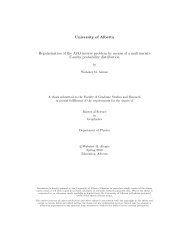Soner Bekleric Title of Thesis: Nonlinear Prediction via Volterra Ser
Soner Bekleric Title of Thesis: Nonlinear Prediction via Volterra Ser
Soner Bekleric Title of Thesis: Nonlinear Prediction via Volterra Ser
Create successful ePaper yourself
Turn your PDF publications into a flip-book with our unique Google optimized e-Paper software.
4.1. LINEAR PREDICTION IN THE F − X DOMAIN 49<br />
frequency:<br />
Sj = A e −ik(j−1)δx<br />
j = 1, . . . , N . (4.5)<br />
One can write a linear event in the f − x domain as a one-step-ahead prediction<br />
given by:<br />
Sj−1 = A e −ik(j−2)δx<br />
= A e −ik(j−1)δx e ikδx<br />
= Sj e ikδx<br />
(4.6)<br />
I can write a recursive form for the prediction <strong>of</strong> the signal recorded at receiver j<br />
as a function <strong>of</strong> the signal at receiver j − 1 (along the spatial variable x) as follows:<br />
Sj = Sj−1 e −ikδx<br />
= a Sj (4.7)<br />
The equation above is the basis for the f − x prediction/deconvolution and SNR<br />
enhancement (Canales, 1984; Gulunay, 1986; Sacchi and Kuehl, 2001). Similarly,<br />
it can be proved that the superposition <strong>of</strong> p linear events (p complex harmonics) is<br />
in a recursive form:









